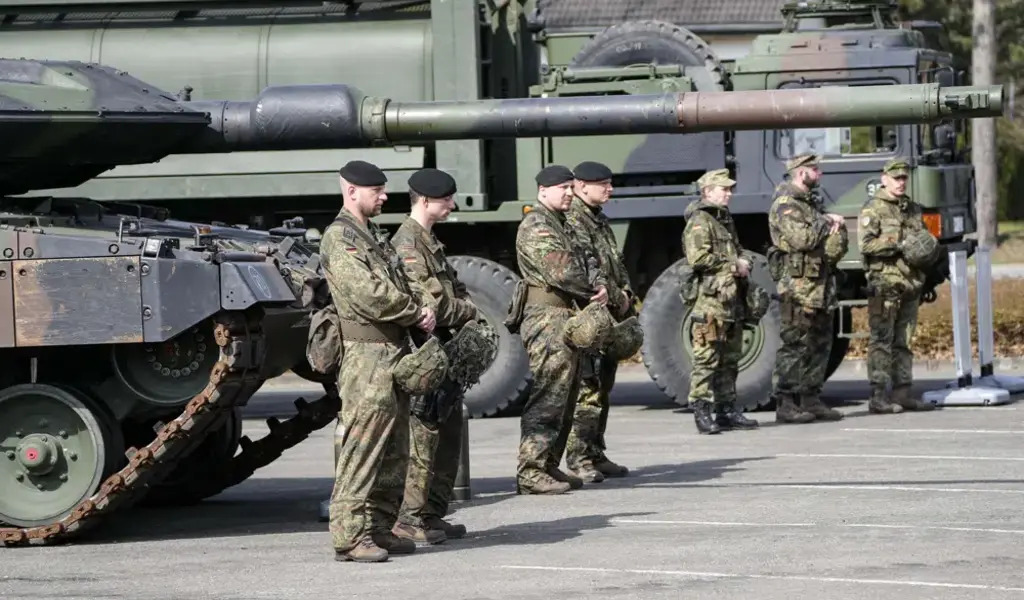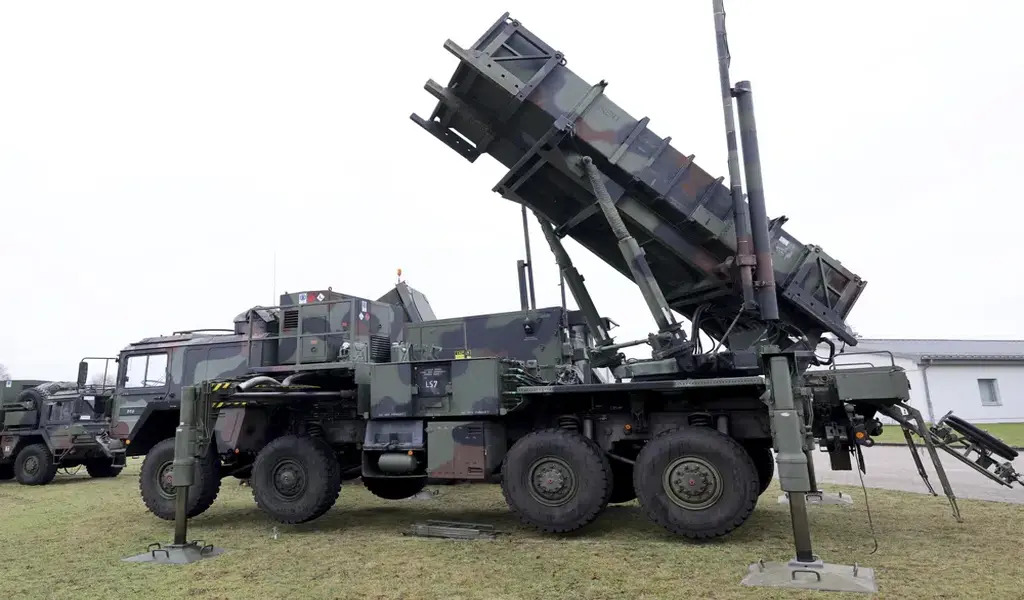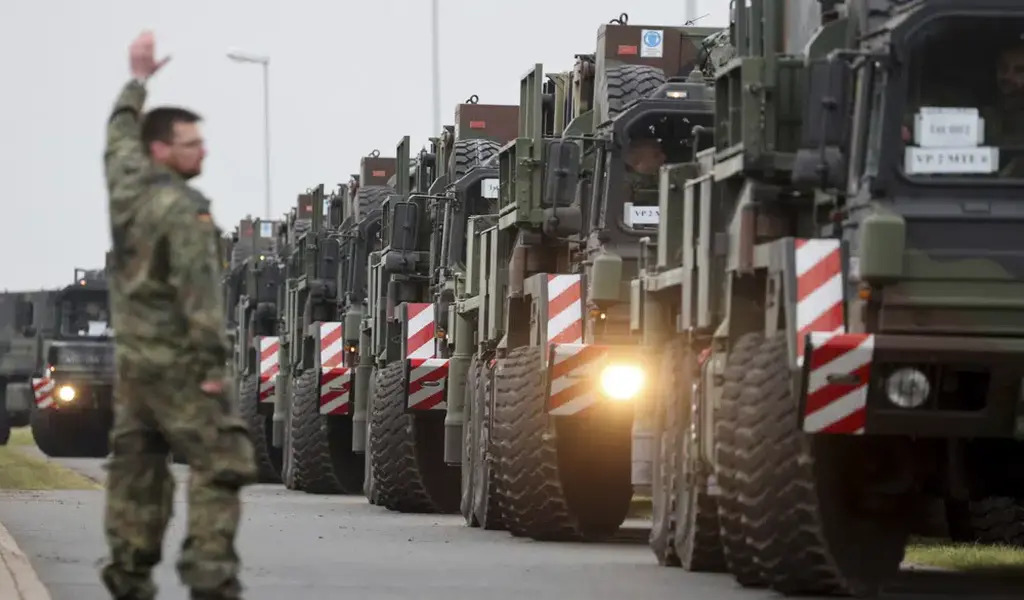News
Poland To Send German-Built Leopard Tanks To Ukraine

(CTN NEWS) – WARSAW, Poland – Poland announced Monday that it would request authorization from Berlin to deliver Leopard tanks made in Germany to Ukraine as its Western allies strive to provide Kyiv with more potent military equipment to fight Russia’s invasion.
To send tanks to Ukraine, Germany has been hesitant.
However, German Foreign Minister Annalena Baerbock’s comments on Sunday that Berlin wouldn’t try to stop Poland from sending Leopard 2 battle tanks gave Polish officials hope.
Mateusz Morawiecki, the prime minister of Poland, omitted to say when the request would be made to Germany.
According to him, Poland is assembling a group of countries prepared to deliver Leopard 2 battle tanks to Ukraine.
For Poland to supply tanks to a non-NATO nation, Germany, the tank’s manufacturer, must give its approval.

/ AP
Morawiecki stated at a news conference that Warsaw would make its judgments even if Germany did not consent.
According to Ukraine, tanks, particularly Leopards, are essential to its military effort. During the winter, the battlefield positions are largely impasses, with new ground offensives anticipated in the spring.
Given that Russia’s troops are significantly larger than Ukraine’s, Kyiv seeks to acquire a technological edge and greater support from its Western friends.
11 months after the Kremlin’s soldiers invaded Ukraine, Poland has emerged as one of the top proponents in the European Union for providing military assistance to help Ukraine win.
Germany’s reluctance has come under fire, especially from Poland and the Baltic nations on NATO’s eastern border who feel particularly threatened by Russia.
Berlin has contributed much, but others have criticized it for taking its time sending military equipment.
Steffen Hebestreit, a spokesperson for the German government, stressed the need for Germany to avoid making a “reckless” decision that it might later come to regret.

/ AP
He continued, “These are difficult, life-or-death questions. We must consider the implications for our nation’s defense.”
When questioned about how long it might take to decide whether to send tanks, Hebestreit responded, “I assume that it’s not a question of months now.”
Polish officials already signaled the readiness of Finland and Denmark to join Warsaw in sending Leopards to Ukraine. The UK has committed to sending Challenger tanks.
The potential of sending Leclerc combat tanks to Ukraine was something that French President Emmanuel Macron claimed he ordered his military minister to “work on” on Sunday.
The decision, according to Macron, will depend on three factors that are also important to other Western leaders:
Whether sharing the equipment will prevent the conflict from escalating, whether it will offer effective and practical assistance when training time is taken into account and whether it will not weaken his military.

/ AP
While several EU nations are considering how to assist Kyiv, Morawiecki claimed that while Poland wants to seek Germany for permission to send Leopard tanks to Ukraine, the request is “a secondary matter.”
Naturally, these are difficult negotiations, but we will make an attempt to overcome countries’ resistance, he said.
Poland hasn’t formally asked Berlin’s permission to share some of its Leopards, but Germany’s top ambassador, Baerbock, said on Sunday that “if we were asked, we would not stand in the way” if Poland did.
Morawiecki responded to Baerbock’s remarks by saying that “exerting pressure makes sense” and that they provide “a flicker of hope” that Germany would join the coalition.
Germany possesses “more than 350 active Leopards and about 200 in storage,” according to Morawiecki.
Poland wants to send a company of Leopard tanks, or 14 of them, but they would hardly make a dent in a war involving thousands of tanks. Warsaw estimates that the tank detachment might enlarge to a brigade size if other nations participate.

/ AP
Berlin has been cautious as it has increased aid to Ukraine, a hesitation that is thought to have historical and political roots.
The most recent information about Western Europe sending tanks to Ukraine, according to Kremlin spokesman Dmitry Peskov, “signaled increased unease among members of the alliance.”
At a summit held on Friday at the German air base at Ramstein, backers of Ukraine promised Kyiv billions of dollars in military assistance.
Defense leaders worldwide talked about Ukraine’s urgent request for Leopard 2 tanks.
But the lack of a deal eclipsed any new military commitments.
EU foreign ministers approved a second 500 million euro ($543 million) military aid package for Ukraine on Monday in Brussels. They also approved funding for a training mission the EU has established for the Ukrainian military.
The funds would pay EU nations back for the arms and ammunition they sent Ukraine. This year’s military training mission for the 27-nation union will cost an additional 45 million euros ($49 million).

/ AP
With this addition, Ukraine has received around 3.6 billion euros from the EU budget.
In response to Kyiv’s military’s promises of cutting-edge Western weapons, Moscow has increased its warnings that escalation risks catastrophe.
The repercussions of escalation could be unforeseen, as we have stated on multiple occasions, according to Sergei Ryabkov, deputy foreign minister of Russia.
“Our signals go unheeded, and Russia’s foes keep the stakes higher,”
The armies of the Kremlin have continued to shell Ukrainian territory.
Kharkiv Governor According to Oleh Synyehubov, on the previous day, Russian soldiers shelled a number of towns and villages in the northeast, killing one citizen and injuring another.
As the war enters its second year, neither side demonstrates any indications of giving up.

/ AP
The Kremlin seems to be considering its options for bringing in more troops. Russian officials announced that the additional 300,000 reservists called up in late October have all been fully mobilized.
However, Russian President Vladimir Putin’s mobilization mandate is still in effect until another presidential decree is published to formally halt the action, according to several Russian attorneys and rights organizations.
The directive is still in effect, according to Peskov, even though the specified number of reservists have been called up, because it also contains “additional measures needed to ensure the completion of tasks by the military.” He said nothing further.
Officials from Ukraine have repeatedly warned that Russia intends to keep deploying more troops.
RELATED CTN NEWS:

News
Trudeau’s Gun Grab Could Cost Taxpayers a Whopping $7 Billion

A recent report indicates that since Trudeau’s announcement of his gun buyback program four years ago, almost none of the banned firearms have been surrendered.
The federal government plans to purchase 2,063 firearm models from retailers following the enactment of Bill C-21, which amends various Acts and introduces certain consequential changes related to firearms. It was granted royal assent on December 15 of last year.
This ban immediately criminalized the actions of federally-licensed firearms owners regarding the purchase, sale, transportation, importation, exportation, or use of hundreds of thousands of rifles and shotguns that were previously legal.
The gun ban focused on what it termed ‘assault-style weapons,’ which are, in reality, traditional semi-automatic rifles and shotguns that have enjoyed popularity among hunters and sport shooters for over a century.
In May 2020, the federal government enacted an Order-in-Council that prohibited 1,500 types of “assault-style” firearms and outlined specific components of the newly banned firearms. Property owners must adhere to the law by October 2023.
Trudeau’s Buyback Hasn’t Happened
“In the announcement regarding the ban, the prime minister stated that the government would seize the prohibited firearms, assuring that their lawful owners would be ‘grandfathered’ or compensated fairly.” “That hasn’t happened,” criminologist Gary Mauser told Rebel News.
Mauser projected expenses ranging from $2.6 billion to $6.7 billion. The figure reflects the compensation costs amounting to $756 million, as outlined by the Parliamentary Budget Office (PBO).
“The projected expenses for gathering the illegal firearms are estimated to range from $1.6 billion to $7 billion.” “This range estimate increases to between $2.647 billion and $7 billion when compensation costs to owners are factored in,” Mauser stated.
Figures requested by Conservative MP Shannon Stubbs concerning firearms prohibited due to the May 1, 2020 Order In Council reveal that $72 million has been allocated to the firearm “buyback” program, yet not a single firearm has been confiscated to date.
In a recent revelation, Public Safety Canada disclosed that the federal government allocated a staggering $41,094,556, as prompted by an order paper question from Conservative Senator Don Plett last September, yet yielded no tangible outcomes.
An internal memo from late 2019 revealed that the Liberals projected their politically motivated harassment would incur a cost of $1.8 billion.
Enforcement efforts Questioned
By December 2023, estimates from TheGunBlog.ca indicate that the Liberals and RCMP had incurred or were responsible for approximately $30 million in personnel expenses related to the enforcement efforts. The union representing the police service previously stated that the effort to confiscate firearms is a “misdirected effort” aimed at ensuring public safety.
“This action diverts crucial personnel, resources, and funding from tackling the more pressing and escalating issue of criminal use of illegal firearms,” stated the National Police Federation (NPF).
The Canadian Sporting Arms & Ammunition Association (CSAAA), representing firearms retailers, has stated it will have “zero involvement” in the confiscation of these firearms. Even Canada Post held back from providing assistance due to safety concerns.
The consultant previously assessed that retailers are sitting on almost $1 billion worth of inventory that cannot be sold or returned to suppliers because of the Order-In-Council.
“Despite the ongoing confusion surrounding the ban, after four years, we ought to be able to address one crucial question.” Has the prohibition enhanced safety for Canadians? Mauser asks.
Illegally Obtained Firearms are the Problem
Statistics Canada reports a 10% increase in firearm-related violent crime between 2020 and 2022, rising from 12,614 incidents to 13,937 incidents. In that timeframe, the incidence of firearm-related violent crime increased from 33.7 incidents per 100,000 population in 2021 to 36.7 incidents the subsequent year.
“This marks the highest rate documented since the collection of comparable data began in 2009,” the criminologist explains.
Supplementary DataData indicates that firearm homicides have risen since 2020. “The issue lies not with lawfully-held firearms,” Mauser stated.
Firearms that have been banned under the Order-in-Council continue to be securely stored in the safes of their lawful owners. The individuals underwent a thorough vetting process by the RCMP and are subject to nightly monitoring to ensure there are no infractions that could pose a risk to public safety.
“The firearms involved in homicides were seldom legally owned weapons wielded by their rightful owners,” Mauser continues. The number of offenses linked to organized crime has surged from 4,810 in 2016 to a staggering 13,056 in 2020.
“If those in power … aim to diminish crime and enhance public safety, they ought to implement strategies that effectively focus on offenders and utilize our limited tax resources judiciously to reach these objectives,” he stated.
Related News:
Millennials in Canada Have Turned their Backs on Justin Trudeau
Millennials in Canada Have Turned their Backs on Justin Trudeau
News
Google’s Search Dominance Is Unwinding, But Still Accounting 48% Search Revenue

Google is so closely associated with its key product that its name is a verb that signifies “search.” However, Google’s dominance in that sector is dwindling.
According to eMarketer, Google will lose control of the US search industry for the first time in decades next year.
Google will remain the dominant search player, accounting for 48% of American search advertising revenue. And, remarkably, Google is still increasing its sales in the field, despite being the dominating player in search since the early days of the George W. Bush administration. However, Amazon is growing at a quicker rate.
Google’s Search Dominance Is Unwinding
Amazon will hold over a quarter of US search ad dollars next year, rising to 27% by 2026, while Google will fall even more, according to eMarketer.
The Wall Street Journal was first to report on the forecast.
Lest you think you’ll have to switch to Bing or Yahoo, this isn’t the end of Google or anything really near.
Google is the fourth-most valued public firm in the world. Its market worth is $2.1 trillion, trailing just Apple, Microsoft, and the AI chip darling Nvidia. It also maintains its dominance in other industries, such as display advertisements, where it dominates alongside Facebook’s parent firm Meta, and video ads on YouTube.
To put those “other” firms in context, each is worth more than Delta Air Lines’ total market value. So, yeah, Google is not going anywhere.
Nonetheless, Google faces numerous dangers to its operations, particularly from antitrust regulators.
On Monday, a federal judge in San Francisco ruled that Google must open up its Google Play Store to competitors, dealing a significant blow to the firm in its long-running battle with Fortnite creator Epic Games. Google announced that it would appeal the verdict.
In August, a federal judge ruled that Google has an illegal monopoly on search. That verdict could lead to the dissolution of the company’s search operation. Another antitrust lawsuit filed last month accuses Google of abusing its dominance in the online advertising business.
Meanwhile, European regulators have compelled Google to follow tough new standards, which have resulted in multiple $1 billion-plus fines.

Pixa Bay
Google’s Search Dominance Is Unwinding
On top of that, the marketplace is becoming more difficult on its own.
TikTok, the fastest-growing social network, is expanding into the search market. And Amazon has accomplished something few other digital titans have done to date: it has established a habit.
When you want to buy anything, you usually go to Amazon, not Google. Amazon then buys adverts to push companies’ products to the top of your search results, increasing sales and earning Amazon a greater portion of the revenue. According to eMarketer, it is expected to generate $27.8 billion in search revenue in the United States next year, trailing only Google’s $62.9 billion total.
And then there’s AI, the technology that (supposedly) will change everything.
Why search in stilted language for “kendall jenner why bad bunny breakup” or “police moving violation driver rights no stop sign” when you can just ask OpenAI’s ChatGPT, “What’s going on with Kendall Jenner and Bad Bunny?” in “I need help fighting a moving violation involving a stop sign that wasn’t visible.” Google is working on exactly this technology with its Gemini product, but its success is far from guaranteed, especially with Apple collaborating with OpenAI and other businesses rapidly joining the market.
A Google spokeswoman referred to a blog post from last week in which the company unveiled ads in its AI overviews (the AI-generated text that appears at the top of search results). It’s Google’s way of expressing its ability to profit on a changing marketplace while retaining its business, even as its consumers steadily transition to ask-and-answer AI and away from search.

Google has long used a single catchphrase to defend itself against opponents who claim it is a monopoly abusing its power: competition is only a click away. Until recently, that seemed comically obtuse. Really? We are going to switch to Bing? Or Duck Duck Go? Give me a break.
But today, it feels more like reality.
Google is in no danger of disappearing. However, every highly dominating company faces some type of reckoning over time. GE, a Dow mainstay for more than a century, was broken up last year and is now a shell of its previous dominance. Sears declared bankruptcy in 2022 and is virtually out of business. US Steel, long the foundation of American manufacturing, is attempting to sell itself to a Japanese corporation.
SOURCE | CNN
News
The Supreme Court Turns Down Biden’s Government Appeal in a Texas Emergency Abortion Matter.

(VOR News) – A ruling that prohibits emergency abortions that contravene the Supreme Court law in the state of Texas, which has one of the most stringent abortion restrictions in the country, has been upheld by the Supreme Court of the United States. The United States Supreme Court upheld this decision.
The justices did not provide any specifics regarding the underlying reasons for their decision to uphold an order from a lower court that declared hospitals cannot be legally obligated to administer abortions if doing so would violate the law in the state of Texas.
Institutions are not required to perform abortions, as stipulated in the decree. The common populace did not investigate any opposing viewpoints. The decision was made just weeks before a presidential election that brought abortion to the forefront of the political agenda.
This decision follows the 2022 Supreme Court ruling that ended abortion nationwide.
In response to a request from the administration of Vice President Joe Biden to overturn the lower court’s decision, the justices expressed their disapproval.
The government contends that hospitals are obligated to perform abortions in compliance with federal legislation when the health or life of an expectant patient is in an exceedingly precarious condition.
This is the case in regions where the procedure is prohibited. The difficulty hospitals in Texas and other states are experiencing in determining whether or not routine care could be in violation of stringent state laws that prohibit abortion has resulted in an increase in the number of complaints concerning pregnant women who are experiencing medical distress being turned away from emergency rooms.
The administration cited the Supreme Court’s ruling in a case that bore a striking resemblance to the one that was presented to it in Idaho at the beginning of the year. The justices took a limited decision in that case to allow the continuation of emergency abortions without interruption while a lawsuit was still being heard.
In contrast, Texas has been a vocal proponent of the injunction’s continued enforcement. Texas has argued that its circumstances are distinct from those of Idaho, as the state does have an exemption for situations that pose a significant hazard to the health of an expectant patient.
According to the state, the discrepancy is the result of this exemption. The state of Idaho had a provision that safeguarded a woman’s life when the issue was first broached; however, it did not include protection for her health.
Certified medical practitioners are not obligated to wait until a woman’s life is in imminent peril before they are legally permitted to perform an abortion, as determined by the state supreme court.
The state of Texas highlighted this to the Supreme Court.
Nevertheless, medical professionals have criticized the Texas statute as being perilously ambiguous, and a medical board has declined to provide a list of all the disorders that are eligible for an exception. Furthermore, the statute has been criticized for its hazardous ambiguity.
For an extended period, termination of pregnancies has been a standard procedure in medical treatment for individuals who have been experiencing significant issues. It is implemented in this manner to prevent catastrophic outcomes, such as sepsis, organ failure, and other severe scenarios.
Nevertheless, medical professionals and hospitals in Texas and other states with strict abortion laws have noted that it is uncertain whether or not these terminations could be in violation of abortion prohibitions that include the possibility of a prison sentence. This is the case in regions where abortion prohibitions are exceedingly restrictive.
Following the Supreme Court’s decision to overturn Roe v. Wade, which resulted in restrictions on the rights of women to have abortions in several Republican-ruled states, the Texas case was revisited in 2022.
As per the orders that were disclosed by the administration of Vice President Joe Biden, hospitals are still required to provide abortions in cases that are classified as dire emergency.
As stipulated in a piece of health care legislation, the majority of hospitals are obligated to provide medical assistance to patients who are experiencing medical distress. This is in accordance with the law.
The state of Texas maintained that hospitals should not be obligated to provide abortions throughout the litigation, as doing so would violate the state’s constitutional prohibition on abortions. In its January judgment, the 5th United States Circuit Court of Appeals concurred with the state and acknowledged that the administration had exceeded its authority.
SOURCE: AP
SEE ALSO:
Could Last-Minute Surprises Derail Kamala Harris’ Campaign? “Nostradamus” Explains the US Poll.
-

 News3 years ago
News3 years agoLet’s Know About Ultra High Net Worth Individual
-
Entertainment2 years ago
Mabelle Prior: The Voice of Hope, Resilience, and Diversity Inspiring Generations
-

 Health4 years ago
Health4 years agoHow Much Ivermectin Should You Take?
-

 Tech2 years ago
Tech2 years agoTop Forex Brokers of 2023: Reviews and Analysis for Successful Trading
-

 Lifestyles3 years ago
Lifestyles3 years agoAries Soulmate Signs
-

 Movies2 years ago
Movies2 years agoWhat Should I Do If Disney Plus Keeps Logging Me Out of TV?
-

 Health3 years ago
Health3 years agoCan I Buy Ivermectin Without A Prescription in the USA?
-

 Learning3 years ago
Learning3 years agoVirtual Numbers: What Are They For?
